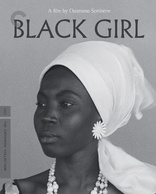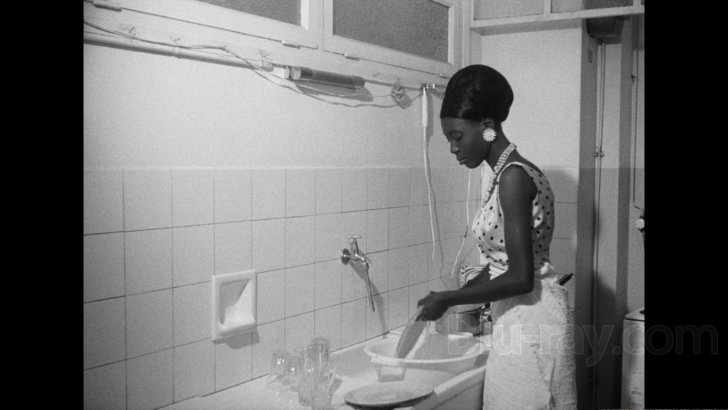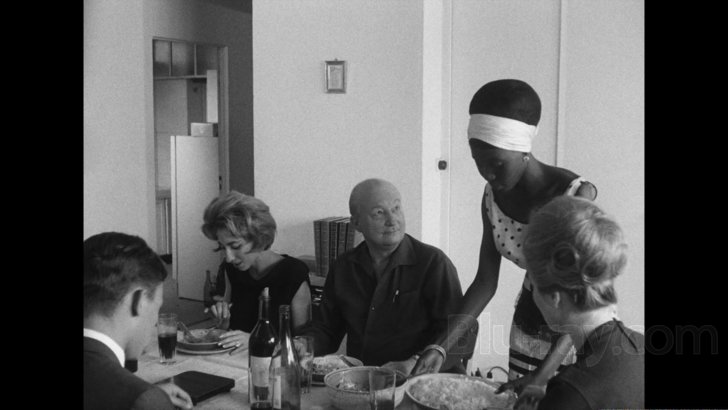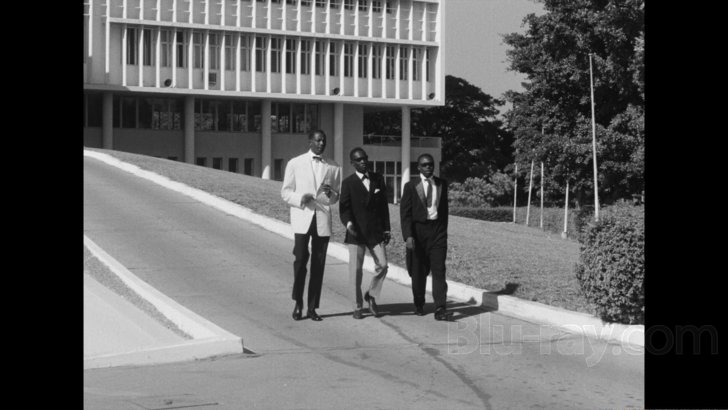Black Girl Blu-ray Movie
HomeBlack Girl Blu-ray Movie 
La noire de... / + Borom SarretCriterion | 1966 | 60 min | Not rated | Jan 24, 2017

Movie rating
7 | / 10 |
Blu-ray rating
| Users | 0.0 | |
| Reviewer | 4.0 | |
| Overall | 4.0 |
Overview
Black Girl (1966)
A young Senegalese woman works as a maid for a wealthy French family who treats her as a slave.
Starring: Mbissine Thérèse DiopDirector: Ousmane Sembène
| Foreign | Uncertain |
| Drama | Uncertain |
Specifications
Video
Video codec: MPEG-4 AVC
Video resolution: 1080p
Aspect ratio: 1.37:1
Original aspect ratio: 1.37:1
Audio
French: LPCM Mono (48kHz, 24-bit)
Subtitles
English
Discs
Blu-ray Disc
Single disc (1 BD)
Playback
Region A (locked)
Review
Rating summary
| Movie | 3.5 | |
| Video | 5.0 | |
| Audio | 5.0 | |
| Extras | 4.0 | |
| Overall | 4.0 |
Black Girl Blu-ray Movie Review
Reviewed by Dr. Svet Atanasov May 7, 2017Ousmane Sembene's "Black Girl" a.k.a. "La noire de..." (1966) arrives on Blu-ray courtesy of Criterion. The supplemental features on the disc include an original trailer for the new 4K restoration of the film; new video interview with actress Mbissine Therese Diop; new featurette with filmmaker and cultural theorist Manthia Diawara; the documentary feature "Sembene: The Making of African Cinema"; and more. The release also arrives with an illustrated leaflet featuring critic and film programmer Ashley Clark's essay "Self, Possessed" and technical credits. In French, with optional English subtitles for the main feature. Region-A "locked".

The maid
The goal of Senegalese director Ousmane Sembene’s first feature film, Black Girl, is very simple. It is to offer two contrasting looks at two different cultures at a specific moment in time. The viewer of course is left with no other choice but to compare the two cultures, and in the process inevitably ponder their obvious flaws.
The black girl that is referred to in the title is named Diouana (Mbissine Therese Diop) and she lives in Senegal’s capital, Dakar. The time is the early 1960s, probably not too long after the country has gained its independence from France. Here Diouana decides to become a nanny for a French family that will soon leave Senegal, as this seems like the only decent job that a young and inexperienced girl like her can hope for. Initially, Diouana could not be happier that she is hired and seems convinced that very soon her life is going to get a lot better, but exactly the opposite happens when she arrives in France and discovers that she has actually been hired to be a servant. Nevertheless, for a while the disillusioned girl decides to keep on performing her duties so that she can save as much as she can and help her family back home. The more time passes by, however, the harder it becomes for her to tolerate the caprices of her employers.
The flipside of the same story is this: Some time after Diouana is discovered in Dakar, her employers arrange that she gets a traveling permit and she then boards a ship that will take her to France. After they reunite, however, the family finds it awfully difficult to deal with Diouana because she isn’t fluent in French, does not like her new duties, and can’t stop thinking about her struggling family in Senegal. It does not help that whenever the family chooses to invite friends for dinner or lunch they treat her like a rare exotic object which they have been lucky to acquire at a competitive auction.
Diouana’s realization that the French way of life which she has imagined has absolutely nothing to do with the mistreatment that she must endure if she wishes to remain in France is the central piece in the film. It is used to reconfirm that the type of division that is observed between Diouana and her employers was essentially a fact of life in France during the 1960s. It is hardly a groundbreaking revelation, though, as the country’s colonial past had clearly shaped up its socio-cultural identity. In fact, even today one can probably easily argue that despite -- or perhaps because of -- its diverse social fabric the country remains fettered by prejudice.
The other important but less obvious point that the film seems willing to make is that at the time Senegal had a similar inequitable social system. There are a few scattered flashbacks in the second half for instance that quickly reveal a comparable division but between Senegalese men and women, as well as some striking discrepancies in the manner in which the two groups perceive the social reality in which they are looking for a better life. So it is hardly a coincidence that when Diouana goes out to find a job she ends up at a popular street corner where other unemployed young women gather on a daily basis, while in a different part of the city nicely dressed men are seen coming in out of brand new administrative buildings.
The film is approximately an hour long and has the appearance of a period documentary feature. In fact, it is not awfully difficult to find many similarities with the fluid style promoted by Edgar Morin and Jean Rouch in the influential Chronicle of a Summer a couple of years earlier, though it is obvious that Sembene had a much smaller budget to work with and far less-experienced crew to rely on.
Black Girl Blu-ray Movie, Video Quality 

Presented in its original aspect ratio of 1.37:1, encoded with MPEG-4 AVC and granted a 1080p transfer, Ousmane Sembene's Black Girl arrives on Blu-ray courtesy of Criterion.
The following text appears inside the leaflet provided with this Blu-ray release:
"This new digital transfer, undertaken by The Film Foundation's World Cinema Project, was created in 4K resolution at L'Immagine Ritrovata in Bologna, Italy, on an ARRISCAN film scanner from the 35mm original camera negative, which was provided by Institut national de l'audiovisuel, and the Ousmane Sembene estate, and preserved at the CNC (Centre national de la cinematographie) - Archives francaises du film. Using a print preserved at the Cinematheque francaise as a reference, L'Immagine Ritrovata performed extensive digital restoration on a wet-scanned transfer to minimize visible scratches and spots that were the results of processing errors and that had been aggravated by time. Invaluable help with the restoration was provided by Alain Sembene. Additional restoration was undertaken by the Criterion Collection using MTI Film's DRS and Digital Vision's Phoenix. The monaural soundtrack was remastered from the 35mm original soundtrack negative by L'Immagine Ritrovata. Additional restoration was undertaken by the Criterion Collection using Pro Tools HD and iZotope RX."
I have never owned a copy of Black Girl on DVD and therefore do not know exactly what type of improvements were made during the restoration process, but I am convinced that this is the very best that the film has ever looked on any home video format. Excluding a few light blemishes that can be spotted during the first lunch where Diouana is asked to serve the rice dish that she has prepared, the film looks spotless. Detail and clarity are also excellent, with the outdoor footage looking particularly good. Depth is optimal, though it appears that some careful rebalancing adjustments were made to ensure that in a couple of areas where some traces of aging might have impacted fluidity the end result is as pleasing as it could be. The color grading is convincing. There is a good range of solid blacks and nicely balanced healthy whites and grays. There are no traces of compromising sharpening adjustments. Image stability is very good. (Note: This is a Region-A "locked" Blu-ray release. Therefore, you must have a native Region-A or Region-Free player in order to access its content).
Black Girl Blu-ray Movie, Audio Quality 

There is only one standard audio track on this Blu-ray disc: French LPCM 1.0. Optional English subtitles are provided for the main feature.
The film does not have a prominent music score. The dialog is clean, stable, all-around nicely balanced, and always easy to follow. Dynamic intensity is very modest, but given the nature of the film and the manner in which it was shot this is hardly surprising. There are no audio dropouts or digital distortions to report in our review.
Black Girl Blu-ray Movie, Special Features and Extras 

- Trailer - original trailer for the 4K restoration of Black Girl. In French, with imposed English subtitles. (2 min, 1080p).
- On Ousmane Sembene - in this new featurette, filmmaker and professor of French Samba Gadjigo (Sembene!) discusses the lasting historical significance of Ousmane Sembene and his work for the popularization of African Cinema. The featurette was produced exclusively for Criterion. In English, not subtitled. (20 min, 1080p).
- Mbissine Therese Diop - in this new video interview, Mbissine Therese Diop recalls how she was cast to play Diouana in Black Girl and recalls how experiences during the shooting of the film. The interview was conducted exclusively for Criterion in 2016. In French, with optional English subtitles. (13 min, 1080p).
- On Black Girl - in this new featurette, filmmaker and cultural theorist Manthia Diawara (African Cinema: Politics and Culture) explains what inspired Ousmane Sembene to shoot Black Girl and discusses some of the political and nationalistic overtones in it. The featurette was produced exclusively for Criterion in 2016. In English, not subtitled. (22 min, 1080p).
- Color Sequence - presented here is a single sequence from Black Girl that was originally shot in color but eventually replaced with one that matches the rest of the black-and-white film. The color sequence was restored by the British Film Institute using a 35mm print that was preserved at the BFI National Archive. In French, with optional/imposed English subtitles. (2 min, 1080p).
- Prix Jean Vigo - presented here is an excerpt from the French television program JT de 20h featuring director Ousmane Sembene shortly after Black Girl had won the Prix Jean Vigo. The program was broadcast on March 22, 1966. In French, with optional English subtitles. (2 min, 1980i).
- Borom Sarret (1963) - presented here is Ousmane Sembene's first short film, Borom Sarret, which won the top prize at the Tours Film Festival in France in 1963. Also included with it is a new filmed introduction by filmmaker and cultural theorist Manthia Diawara.
1. Introduction. In English, not subtitled. (13 min, 1080p).
2. Borom Sarret. New 4K restoration of the film. In French, with optional English subtitles. (20 min, 1080p).
- Sembene: The Making of African Cinema (1994) - this archival documentary film, produced by Manthia Diawara and Thiong'o Ngugi-wa, examines the socio-cultural climate in Africa during the 1990s and the state of the local film industry, Ousmane Sembene's creative philosophy and political views, and the evolution of African culture after the end of the colonial era. In English and French, with optional English subtitles where necessary. (61 min, 1080p).
- Laflet - an illustratde leaflet featuring critic and film programmer Ashley Clark's essay "Self, Possessed" and technical credits.
Black Girl Blu-ray Movie, Overall Score and Recommendation 

Senegalese filmmaker Ousmane Sembene's work has an undeniable historical significance because it is directly responsible for the emergence and establishment of African cinema. However, I also think that it is important to view and evaluate in the proper context, which would be as an extension of his writings that questioned the neo-colonial order in Africa and openly promoted many of the controversial ideas and values that emerged from the radical Left in France. In other words, it is not a bad idea to approach Sembene's work with the same caution that you would use when considering Jean-Luc Godard's politically charged work. Sembene's first feature film, Black Girl, has been recently restored in 4K and looks rather impressive in high-definition. Criterion's recent Blu-ray release also offers some very good new and archival supplemental features that focus on Sembene's legacy and political activism. RECOMMENDED.
Similar titles
Similar titles you might also like

Au hasard Balthazar
1966

The Class
Entre les murs
2008

Goodbye to Language 3D
Adieu au langage
2014

Panique
Panic
1946

The Flower of Evil
La fleur du mal | 4K Restoration
2003

The Image Book
Le livre d'image
2018

Young & Beautiful
Jeune et jolie / Slipcover in Original Pressing
2013

Zama
2017

Happy End
2017

Touki Bouki
1973

Soleil Ô
Oh, Sun
1967

Heroic Purgatory
煉獄エロイカ
1970

One Sings, the Other Doesn't
L'une chante, l'autre pas
1977

The Fire Within
Le feu follet
1963

Lourdes
Slipcover in Original Pressing
2009

Out 1
Out 1, noli me tangere
1971

Mandabi
1968

Muriel, or the Time of Return
Muriel ou le temps d'un retour
1963

Like Father, Like Son
2013

Murmur of the Heart
Le souffle au coeur
1971